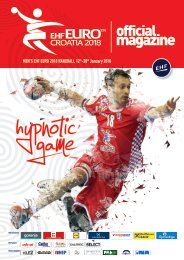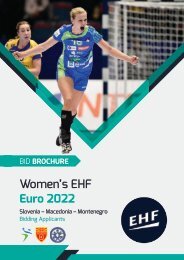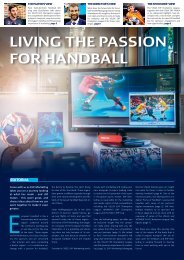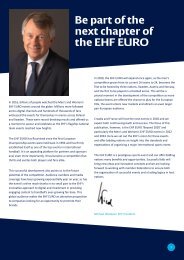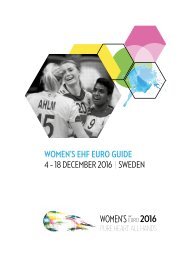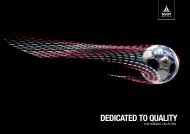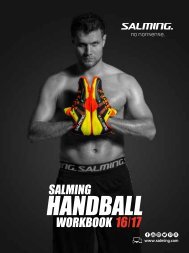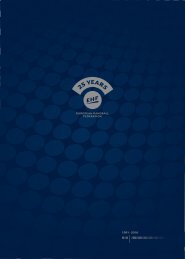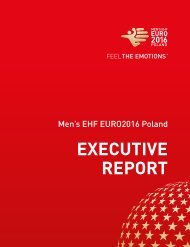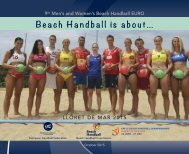ehf_25yers_book_webversion (1)
Create successful ePaper yourself
Turn your PDF publications into a flip-book with our unique Google optimized e-Paper software.
Today, some of the problems that confronted<br />
the EHF Office in Vienna in its first<br />
few years appear very trivial. But, back<br />
then, the internet was still the great unknown.<br />
Today, information is distributed<br />
around the globe within fractions of a second.<br />
In the early 1990s, organisational<br />
processes sometimes came to a halt<br />
as communication was either largely unfeasible<br />
or a very complex affair. At that<br />
time, not all member federations had a<br />
telephone or a fax machine at their disposal.<br />
Sometimes, it took weeks for a<br />
match planned in Azerbaijan or Moldova to<br />
be confirmed.<br />
It is therefore no surprise that, as early<br />
as 1993, Alexander Toncourt, assistant<br />
General Secretary, did all he could to build<br />
a communication system designed to facilitate<br />
work for the national federations<br />
as well as for the EHF and the media. The<br />
magic word was: computers! Computers<br />
were the tool that the EHF wanted to use<br />
to record the results of European Cup and<br />
European Championship matches, to pass<br />
them on to news tickers as quickly as possible<br />
and to develop a sound database for<br />
coming generations. This was the vision on<br />
which work commenced with much vigour<br />
in 1994. On 9 and 10 December 1994,<br />
delegates from more than 20 member<br />
federations were trained at the 1st International<br />
Seminar on Computer Info System.<br />
A second workshop was held in Sofia<br />
in early 1995.<br />
The introduction of electronic data processing<br />
was an important step into modern<br />
times. In another field, Dansk Håndbold<br />
Forbund (DHF) rendered valuable development<br />
assistance to the EHF. When the<br />
2nd Women’s EHF EURO ended in Denmark<br />
in 1996, EHFs mobility received an<br />
unexpected boost. “After the finals we were<br />
told that we could take home to Vienna a<br />
number of mobile phones that had been<br />
used by the organising committee and that<br />
were no longer needed,” Markus Glaser<br />
remembers, with a smile on his face. “This<br />
was basically what enabled us to set up the<br />
EHF hotline. This hotline was created after<br />
the EHF Women’s EURO 1996 in Denmark<br />
so that the member federations were<br />
able to contact someone even on weekends.”<br />
The number of the hotline has since<br />
remained unchanged.<br />
This little anecdote illustrates how difficult<br />
these pioneering years were in some<br />
respects. Nonetheless, the new structural<br />
organisation proved workable from the<br />
very beginning. After the first key meetings<br />
– the meeting of the EHF Committee<br />
in Hamburg on 15 December 1991 and<br />
the 1st Ordinary EHF Congress in Vienna<br />
in June 1992 – the delegates conducted<br />
the EHF Youth European Championships<br />
in Hungary and in Switzerland without any<br />
major problems.<br />
1993, the year when Markus Glaser and<br />
Helmut Höritsch joined the Vienna Office<br />
as additional full-time staff, saw not only<br />
the start of the European Cup project,<br />
which the EHF had taken over from the<br />
IHF. By that time, two additional EHF Congresses<br />
had already been staged: the 1st<br />
Extraordinary EHF Congress in Barcelona<br />
in July 1992, organised in the run-up to the<br />
Olympic Games, and the 2nd Extraordinary<br />
EHF Congress in Antwerp. At this initial<br />
stage of the EHF’s development, the main<br />
focus was on competition-related and organisational<br />
matters.<br />
On 6 and 7 August 1993, the EHF held<br />
a conference in Vilnius (Lithuania) on the<br />
structures and mechanisms of the European<br />
umbrella organisation as an informational<br />
event for 16 newly admitted<br />
member federations. By that time, the EHF<br />
already had a total of 45 members. And<br />
then the EHF administration even organised<br />
two matches of a European selection:<br />
on 3 January 1992, a men’s continental selection<br />
played a match against Austria in Vienna,<br />
and on 26 June Poland‘s female national<br />
team played against Euope at Zarbze.<br />
This heaped a heavy workload on the<br />
still very lean staff in Vienna, all the more<br />
so as the EHF administration also had to<br />
prepare and support the work and meetings<br />
of Congresses, the Commission and<br />
working groups.<br />
That these meetings proceeded mostly<br />
smoothly, constructively and in a spirit of<br />
harmony was also attributable to the amazing<br />
continuity in the officers serving on the<br />
elected bodies. Until the year 2000, there<br />
was hardly any change in the team that had<br />
started the EHF project in 1991. President<br />
Staffan Holmqvist, who was recognised<br />
by all parties as the leading figure, served<br />
35



